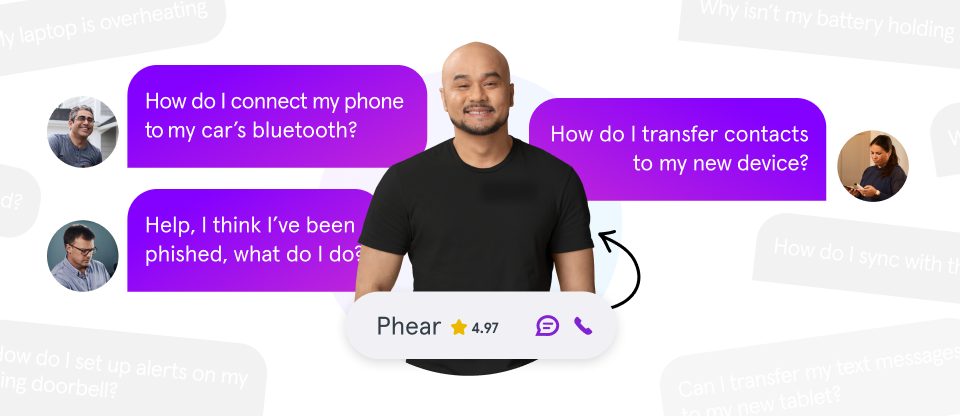Any time you use the internet—whether it's to read the news, share opinions on social media, research a vacation, subscribe to a newsletter, or order medication—you leave behind a trail of data. All that data is what's called your digital footprint.
If you've never heard that term before—or if you're unclear on how you can protect your own digital footprint—you're in the right place.
Asurion Experts help our millions of customers enjoy their tech without worry every day—from teaching people how to protect their phone from hackers to offering their advice on the best password managers.
Here's our guide to your digital footprint, including what you can do to keep your personal information safe.
What is a digital footprint?
Think of your digital footprint as the evidence of your life online. Pretty much all of your online activities contribute to it: From sending emails and browsing social media to online banking and even fitness monitoring, every link you click, app you use, and service you sign up for is being tracked.
Why digital footprints are important
Your digital footprint is (mostly) permanent, so you have little control over how companies use the data you leave behind. It's legal for advertisers and websites to collect information about your online habits, sell or share that data with third parties, and send you targeted ads.
Your digital footprint is also fertile ground for criminals and hackers, who may try to use all that data to steal your identity or target you for fraud.
Finally, your digital footprint is like your digital reputation. Content, photos, videos, and opinions that you post all form part of your online identity. Colleges and universities can check applicants' digital footprints before deciding who to accept. Potential employers may do the same when making hiring decisions.

Don’t waste time scrolling
Life is short. Ask our experts and get answers now.
To understand what your digital footprint looks like, type your name into a search engine, such as Google® or DuckDuckGo®. Be sure to include both your first and last names as well as any variations (like a birth name or nickname). The search results are part of your digital footprint, though they are by no means exhaustive.
If you want to get regular updates anytime your name appears online, you can do so automatically, for example, by setting up a Google Alert.
How to protect your digital footprint
There are many ways to protect your digital footprint, from regularly updating your software to avoiding unsafe websites (make sure you see “https" at the beginning of the URL before buying, for example). To minimize the data you leave behind, follow these recommendations from our experts.
Use privacy settings on social media
Social media platforms automatically make your information public unless you switch your settings to private access. Privacy settings let you control who sees your social media posts, restricting access to friends or close contacts. Think about it: Does the whole world really need access to your personal life? Protect your online reputation and limit your content to those who you actually know.
Limit what you share
Think before sharing personal information on social media, including your location and contact info. Can any of this information be used against you or to find you?
To make it harder for cybercriminals to access your information, don't like or follow your pharmacy, bank, and other organizations.
And if you're sending forms or questionnaires to seek out information, remember that you're also giving away your personal data, so try to find what you're looking for another way.
Use a secondary email
When signing up for commenting platforms (like for your local newspaper's website) or online shopping, swap out your main email address for a secondary one. This will make it harder for people and companies to grasp the full picture of how you spend your time online.
Don't log in with Facebook or other social media accounts
If you've been logging in to websites through your Facebook® account or other social media sites, you may want to stop—you're giving that company permission to scrape your data. Instead, use your email address and an unique, strong password.
Use a virtual private network (VPN)
A VPN hides your IP address, encrypts your traffic, and makes you anonymous online. The result: A reduced digital footprint and fewer opportunities for companies to collect your info. To learn more, read our guide to VPNs.
Don't rely on incognito mode
Incognito mode (or private browsing mode) prevents your web browser from saving data about you as you spend time online. It's great when you're sharing a computer with other people or researching a gift for your spouse, because your browser will automatically delete your search history. But incognito mode doesn't offer total online privacy. While it erases data saved on the device you're using, like cookies, it doesn't delete records of websites you visit or protect you from third-party tracking. A VPN offers a much higher level of protection.
Opt out
You may have noticed that some websites let you opt out of letting them sell your personal data. Anytime you have this option, take it. The exact steps vary based on the site you're using (say Google® or Spotify®) but generally speaking, navigate to the privacy or settings menu to opt out of tailored/personalized ads.
Read the fine print
It may be dull but reading user agreements before installing apps or signing up for websites and newsletters will give you a sense of the information companies collect about you and how they'll use it.
How to erase your digital footprint
It's incredibly difficult to erase your online presence entirely, but these steps will help you remove much of it.
Delete or deactivate old online accounts
This includes social media, shopping, and online service accounts, including obvious ones (like Instagram® and Facebook®) as well as sites you may have forgotten about (like MySpace® and Tumblr®). Think about shopping sites you may have registered for years ago to send a wedding gift and sites you signed up for to get a discount on a purchase.
If you use a password manager, it's a great cheat sheet for remembering all your accounts. For each one, sign in, navigate to the account settings, then look for a privacy/security tab (or something similar). From there, you should be able to deactivate your account.
Remove your information and posts from websites
If just thinking about the blog posts you wrote back in the aughts makes you shudder, it's time to remove them. You'll have to contact the webmaster of each site; you can usually find their information under the Contact or About Us section.
Remove old search results
Let's say you change jobs. Sometimes, even though your previous company removes you from its About page, that very page still shows up in search results when you Google your name—even though your name is gone. That's because the old version of the About page is cached on a Google server.
To fix it, send the URL to Google or another search engine using its Remove Outdated Content tool. Keep in mind that Google may not honor your request, but it's worth trying.
Opt out of data brokers
Data brokers, like FastPeopleSearch, Radaris, MyLife®, and PeekYou®, collect your personal information and sell it to third party companies. Some let you opt out, but the process isn't easy.
The DIY approach involves contacting each site, one at a time, and asking for your name to be removed—and doing so may involve making phone calls, sending emails, filling out forms, even providing personal information.
There are also services that'll do the work for you, for a fee. Keep in mind, removing your information from data broker sites will effectively remove your digital identity from Google.
Delete cookies
Anytime you use a browser, like Chrome® or Safari®, it saves some website information in its cache and cookies. To prevent websites from being traced back to you, it's a good idea to delete cookies once in a while. You can do this in your browser, under the settings. Just know that deleting cookies will remove your saved log ins, so you'll have to enter your username and password again.
Unsubscribe from newsletters and mailings
Another way to minimize your digital footprint is to unsubscribe from brand newsletters, like daily emails you receive from stores, magazines, and content creators. Just look for the unsubscribe button at the bottom of the email or contact the company via their About page and ask to be removed from their list.
Remove personal information from websites
If someone posts your sensitive information on a website, like your address, phone number, or bank account, contact the webmaster immediately and ask for it to be removed. If they won't remove it, send a request to Google or another search engine to have that content legally removed. This process can take some time, and it may or may not work. But it's your best chance at protecting that personal info.
Delete digital history on social
Email and social media have been around for decades now, which means years (and years) of content are just sitting out there online. To clean up your digital footprint, you can bulk-delete old emails on Gmail™ by going to the search bar and using “older_than:" in your search. Choose your time period and then delete everything that comes up.
X® won't let you bulk delete tweets, but third-party services will help you, for a fee. You could also simply delete your Twitter account.
Tried these steps and still need help? We got you. Get your tech problem solved when you call or chat with an expert now.





